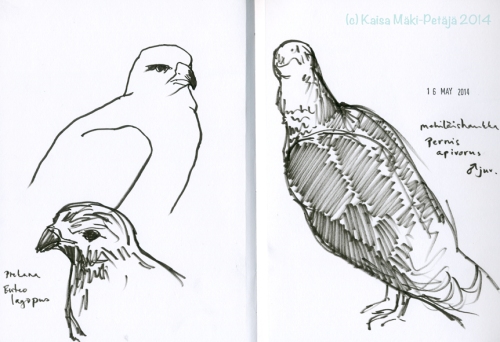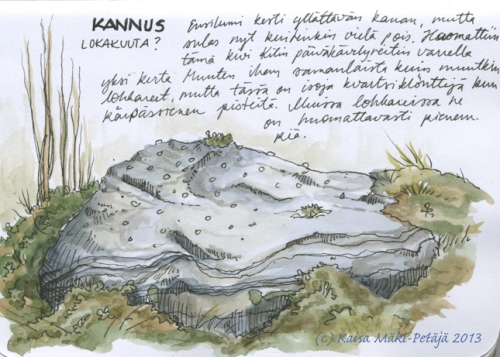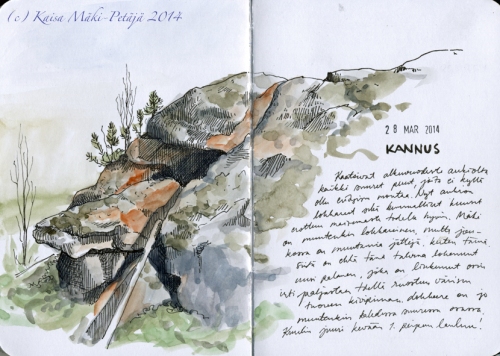Quinn from QuinnCreative asked if I wanted to participate in blog hopping and of course I said yes! But first of all, I must apologise if you, dear reader, followed the link on Quinn’s blog and found nothing new here. I meant to write and post this earlier today but the archeological hike with a local archeology enthusiasts we had this morning lasted much longer than I anticipated. We had a great day! Warm, really warm for May – close to +30 C/+86 F – but that didn’t stop us from spending five and half hours roaming around the rocky forest ridges hunting for prehistoric burial mounds and stuff. Maybe I should post about that too sometime.
Enough of that for now. There are some questions I’m supposed to answer.
What are you working on? Have you heard of the Sketchbook Skool by Danny Gregory and Koosje Koene? I enrolled on their first ever semester, ‘The Beginnings,’ and that is what I have been working on lately. My Ph.D. theses has been under the scrutiny of the pre-examiners so I have had more free time to spend drawing etc. One assignment we have had was to go to a natural history museum to draw, and Friday last week I visited the local natural history museum Kieppi with my friend and we spend few hours there drawing what ever we found interesting. Here is some stuff that I drew there:
The first drawing on the left is also a partial answer to the second question: How does your word differ from others of its genre? I don’t know if the end products of my creative process are that different from others but the way I observe things is not, I think, that common. When I draw or paint I don’t transform three dimensional objects into outlines and contours onto the two dimensional surface of paper. I have a pretty strong sense of space, spatial relations and mass and I sort of carve out the object on the paper. It’s difficult to explain but I kind of feel out in my mind the 3D-shape of the thing I’m drawing, its textures and its form (all sides, mind you, not just the front). Drawing contours is really hard for me but that’s what I wanted to practice on during my museum visit. So I first drew the seed of the cannonball mangrove, Xylocarpus granatum, on the left to get that need to carve things out of my system. After that it was easier to perceive things, like the seagulls on the right, as contours.
Why do you write/create what you do? Because it deepens my contact with the world. Drawing is a way to touch things, to know them and not just to know about them. Drawing is special way of being-in-the-world. It’s so much more than just looking at and seeing things. It is the ultimate form of observation in my mind – for me at least. And I want to show folks what an incredible world spreads about them. For example, while I was writing that previous sentence a large beetle crawled in from our backyard. I captured it in a jar, memorised its overall appearance and returned it outside. There are myriad things to see out there (and in here) and I wish to share them with you.
BTW, the Finnish word for fulmars is rather romantic: myrskylintu, ‘storm bird.’
How does your writing/creative process work? At first I always fiddle about too much. It’s the same with my philosophical writings (I don’t do science, I’m a philosopher!) and drawing or any other creative activity. I get caught up in the details. I want to draw everything and write and read about everything. It takes a while to figure out what details are necessary, which ones lead to discoveries and which ones are just white noise. I can’t bypass that part of the process, in fact it is elemental for my thinking. I can, however, speed it up a bit by accepting and allowing it like I did with the cannonball mangrove: I do what I have to and get on with it. It can sometimes get really muddy and confused in my mind but I don’t mind as I know it will clear up soon and I will discover something unexpected. I never know what waits me at the end of a path I’m following but I know it’s worth it.
That’s my four questions answered. I didn’t have time to find the next link for the blog hop but I will do that during the next week. In the mean time you can check out this great BBC documentary series, What Do Artists Do All Day on YouTube. A varied bunch of interesting British artists doing they thing and talking out loud about it.






